Introduction
Bratislava’s Innovation Team: mission and objectives
Bratislava’s digital transformation is conducted by the Department of Innovation and Digital Services (“the Innovation Team”). The Innovation Team is made up of 15 in-house employees (project managers, product managers and IT developers) as well as an external UX design team. The work is led by a Chief Information Officer of the City of Bratislava, a position first held by Petra Dzurovčinová (2018-2023). Since January 2024, Zuzana Šefčík Aschenbrennerová has headed the team. The department was established in 2018 and has been responsible for devising and implementing Bratislava’s modernisation and digitalisation strategies. It is situated within the City of Bratislava’s administration structure, forming part of the Deputy Mayor’s Office. The administrative jurisdiction of Bratislava’s municipality encompasses the area of 17 boroughs. Originally, the department was tasked with revamping the city’s website – bratislava.sk – which was underperforming and generating excessive costs for the city. Since then, the Innovation Team’s mandate has grown to encompass several projects, including the flagship Bratislava ID.
Nowadays, the Innovation Team cooperates with 10 public sector bodies in the City of Bratislava which carry out certain tasks like management of municipal waste, city greenery or sports and recreation (“Municipal Companies”), and all 17 of Bratislava’s boroughs to harmonise and modernise their digital services. From the outset, the department has operated in line with the Public Money, Public Code ideals of collaboration, auditability and innovation. Relying on open source solutions means that the capital can better serve its citizens and foster affordable, creative ideas in the public sector. The list of all running projects can be found on the Innovation Team’s website.
As underlined in Bratislava’s 2022 Urban Innovation Strategy, the department’s guiding principles are contained within the “quintuple helix cooperation,” which is an innovation system that highlights the need for cooperation across the public, private, academic and civic sectors. Recognising that knowledge-sharing can enable providing solutions to complex social and environmental challenges, the department has set up the Bratislava City Lab.
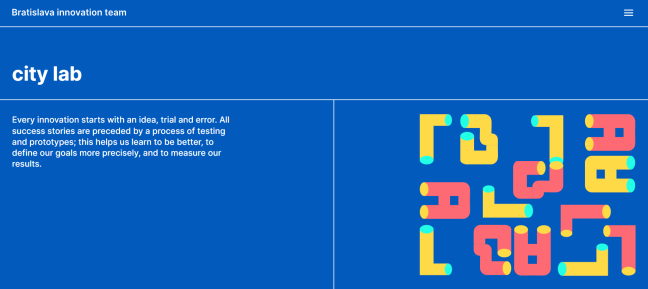
The City Lab is an open innovation platform that creates a safe space for testing innovations through controlled experiments of pilot solutions within five thematic areas: efficient urban mobility, adoption to climate change, energy efficiency and neutrality, knowledge-based decision-making, and digital transformation.
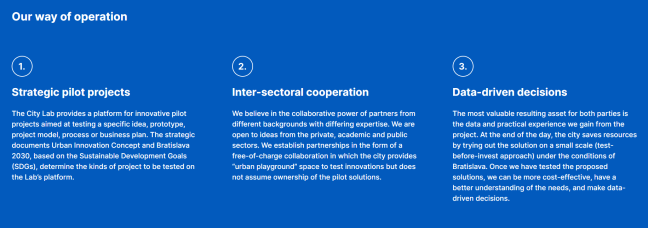
data-driven decisions (Image source: City Lab)
Through the open source digital projects developed by the Innovation Team, Bratislava has set out to improve the user convenience and inclusivity of its digital services. Over the long-term, these are meant not only to reduce costs and increase efficiencies for the city, but to also facilitate cooperation between different municipal companies. As such, the city is building its digital innovation strategy around inclusivity, ensuring that digital products and city services are provided to all residents, regardless of their background.
Bratislava ID
In line with its Urban Innovation Strategy, the City of Bratislava has been building a complete ecosystem of open source digital services that the city, its municipal companies and 17 city boroughs can use to make access to their digital services easier, faster, more trustworthy, and more transparent. The Innovation Team’s flagship project has been the Bratislava ID, which is built atop an open source API. Citizens can use one account to access multiple municipal services online such as paying their property taxes, buying swimming pool tickets, and following the status of their administrative requests. Only the full legal name, an email address and a password are required to sign up for the city account. For services with a higher level of security, verification takes place either via the national eID or via a national ID number and date of birth which are checked against the data contained in the national register. In this way, the city offers access to its digital services even to people who do not use the national eID; in Bratislava, only about 12% of residents make use of the national eID.
The release of Bratislava ID took place in April 2023, with the service first becoming available to physical persons. Eventually, access to the city account was extended to legal persons in autumn 2023. This step-by-step rollout is in line with the findings of the Urban Innovation Strategy, which conducted a survey and received the feedback that over three quarters of Bratislava’s citizens feel that technology should be introduced gradually. Moreover, since the ID is based on open source code, it can be easily adapted by other municipalities. Bratislava’s Innovation Team has been in consultation with two other Slovak municipalities (obec) to expand the service beyond the capital.
Using Bratislava ID enables citizens to access a multitude of services online. Platba Dane, one of the solutions developed as part of the new eID, is an easy, GDPR-compliant tool for property tax payments. Enabling citizens to file all the necessary documents online has improved their user experience and made paying taxes much faster. Within 72 hours from the launch of the solution, 54.3% of taxpayers paid their tax, with 69% using a QR code, and the remainder accessing the service through a payment gateway.

online (Credit: Petra Dzurovčínová, former City of Bratislava’s Chief Innovation Officer)
That constitutes a significant year-on-year improvement: in 2021, only 39% of taxpayers submitted their forms within the same window time. According to the feedback collected by the city administration, 93% of residents would recommend this service to a friend. Moreover, Platba Dane has also lowered the costs for the city: prior to the introduction of the service, tax returns were mailed to citizens via post. Each tax season, around 200,000 copies were sent out to taxpayers, with the costs reaching 3.50 EUR per envelope. As of autumn 2023, over 27,000 residents have signed up for the online service.
Bratislava ID also enables citizens to enjoy leisure activities by buying swimming pool tickets via the Kupaliska website, which features an interactive map displaying the swimming pools in the city.
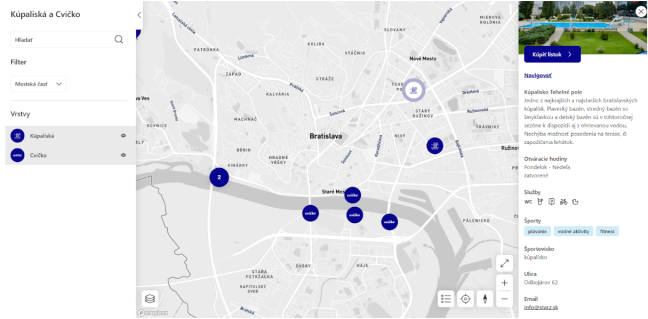
the opening hours, available amenities, the location and the contact
information of the swimming pool (Image source: Kupaliska website)
Citizens can choose from seasonal, 10-day and single-day tickets that give them access to seven public swimming pools managed by STaRZ, the municipal company in charge of sports and recreational activities.
Bratislava goes online
Revamp of the digital identity of Bratislava’s services and its municipal companies
The Innovation Team’s first project was the revamp of the City of Bratislava’s main website. With the resulting expertise, code and tools, the Innovation Team charged ahead and developed other websites helping citizens to navigate the city's public services. The new website’s API is open and is built with open source modules, such as open maps based on Mapbox, an open source graphics library that relies on OpenStreetMap’s API. Besides the website and the flagship Bratislava ID project, the Innovation Team has also been working on setting up a catalogue of secondary websites that offer information to the citizens and which feature open source modules.
One of these websites is Cvičko, offering an overview of outdoor gyms as well six public training areas on the banks of the Danube River, all of which are free of charge and open to the public. The website features an interactive Mapbox map and training videos.
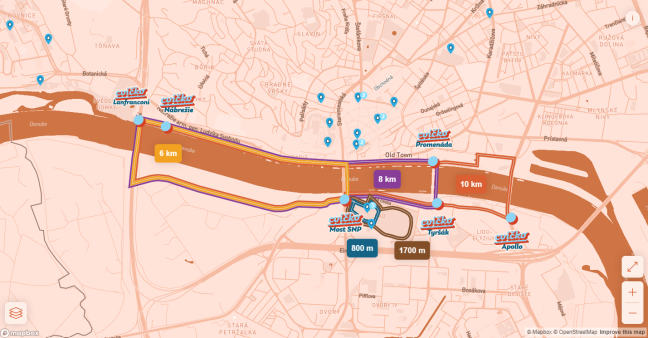
name, types of activities available and its location. Five running routes of 500 m, 1.7 km,
6 km, 8 km and 10 km are marked in different colours. The user can also see the location
of the open-air gyms by clicking on the blue pins. (Image source: Cvičko website)
The Innovation Team also devised a plan to work with 10 municipal companies, helping them to improve their online services, with the frontend and the content management system (CMS) of each being released as open source under the EUPL-1.2 licence. The work with five of these organisations is already completed. Nadácia Mesta showcases the cultural and communal projects conducted by the Bratislava City Foundation, while Mepasys offers information on vehicle towing services by the Municipal Parking System. Furthermore, for practical information about municipal funeral services, Bratislava residents can visit Marianum. Similarly, residents can access the city library services through the interactive Metstka Knižnica website. Lastly, information about the Bratislava City Gallery is available via GMB.
Throughout 2023-2024, there has been ongoing work on a revamp of the e-government services portal, eSlužby. This website was procured from an external provider and access to services offered there is only available to citizens who hold some form of eID. Due to this limited access, the website has only been used by about 8% of residents. The maintenance costs of eSlužby, which amount to over 45,000 EUR a year, are seen as excessive and the city sees a clear need to move towards a more financially prudent and sustainable solution, with open source as a key element of the planned strategy.
Mapping green ambitions
The digitalisation of the city's services goes hand in hand with Bratislava’s sustainability ambitions, as reflected in the high number of digital initiatives related to nature and green spaces. In April 2022, the city launched its 10,000 Trees initiative, setting a goal of planting ten thousand additional trees in Bratislava’s parks and urban spaces by the end of 2022. As part of this effort, the 10,000 Stromov website was set up to offer information to citizens and companies interested in supporting the capital’s green ambitions. The website hosts an interactive map, built using OpenStreetMap’s API, to help organise the expansion of areas for plants and trees in the city, and to display the progress.
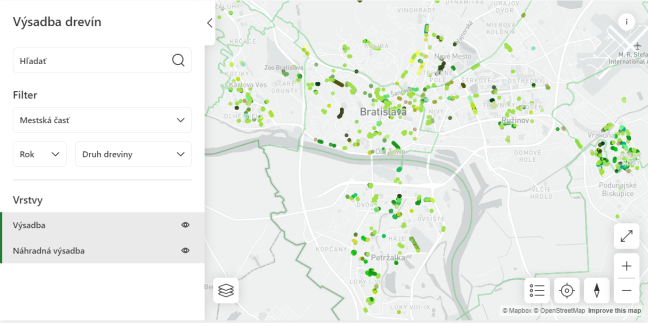
year it was planted. (Image source: 10,000 Stromov website)
Urban mobility via apps
Furthermore, the Innovation Team has also seamlessly integrated open source-based solutions into Bratislava’s urban mobility schemes. In line with the city’s aspirations of boosting the use of Bratislava’s public transportation network, the Innovation Team has developed an open source-based mobility app called Po Meste. This multimodal journey planner suggests routes for navigating the city using public transport, micromobility or Mobility as a Service (MaaS) means. Additionally, following the reintroduction of city-regulated parking zones in July 2023, the Innovation Team has led the development of Paas, a city-owned parking app that has streamlined access to parking in the capital. The Paas app has been in development as an open source app that will offer a single point of entry for drivers looking to purchase an hourly ticket or a resident parking pass. It is planned as a replacement for the current payment system, which is composed of 6 proprietary parking ticket providers.
Lessons learnt
As indicated in the Urban Innovation Strategy, digitalisation of the City of Bratislava forms part of a larger innovation plan that aims to transform the capital into a more sustainable, resilient and liveable city. By gradually introducing new digital services, starting with the Bratislava ID, the city is ensuring that its digital transformation leaves no one behind. Similarly, the popularity of the Platba Dane platform for property tax payments proves the demand for digitally enabled administrative processes. Moreover, by using open source-based solutions for Bratislava ID, Platba Dane as well as the city’s websites and upcoming projects (e.g. parking app), the city is leading the way in a democratic, transparent and collaborative digital transition process.
The ongoing digital transformation of Bratislava’s public services is not without its challenges; the innovation-first approach of the city has been met with some resistance. While citizens are enthusiastic about the convenience that comes with a modern public administration, organisational barriers persist. Firstly, following the September 2023 parliamentary elections in Slovakia, a new cabinet has been appointed, and the personnel changes on the ministerial level have caused a slowdown in the development of projects. For Bratislava’s Innovation Team, the changes at the Deputy Prime Minister's Office for Investments and Informatisation of the Slovak Republic are particularly relevant as this is the body responsible for setting the direction of the country’s digitalisation.
Similarly, interdepartmental tensions sometimes occur within the city hall as the Innovation Team’s creative mandate comes into conflict with the other departments’ operating methods. When it comes to expanding the services to other municipalities, the Innovation Team has also encountered issues, particularly those related to the lack of qualified staff in city halls outside of Bratislava that could carry out similar projects beyond the capital. This issue is attributed to the migration of highly skilled workforce to Bratislava, which leaves many municipalities outside of the capital without the personnel necessary to carry out the urban innovation tasks.
Conclusion
Under Petra Dzurovčinová’s direction, the City of Bratislava’s Department of Innovation and Digital Services set the Slovak capital on a path towards digital transformation. Their implementation of open source solutions is based on a clear commitment towards openness, collaboration, and innovation in the public sector. From the revitalisation of the city's website to the development of the Bratislava ID and various digital services, the city has been dedicated to enhancing users’ experiences, simplifying administrative procedures, and fostering inclusivity in its technological advancements. Importantly, since the beginning of its operation, the Innovation Team has relied on open source solutions and remained in alignment with the principles of Public Money, Public Code.
The rollout of the Bratislava ID is a testament to how the city is transforming citizen access to municipal services through solutions that are designed with accessibility and ease of use in mind. Moreover, the success of initiatives like Platba Dane demonstrates not only improved user experiences but also cost reductions for the city, underscoring the practical benefits of digitalisation based on open source solutions. When considered together with the successful collaboration with municipal companies (art gallery, library or funeral services), it is clear that Bratislava’s Innovation Team has meaningfully enhanced the digital experiences of Bratislava’s residents.
Some organisational and political obstacles stand in the way of a more comprehensive digital transition of Bratislava’s public services. This is particularly visible in the ongoing attempts at expanding and transposing the city’s digital solutions, particularly its city account, to other municipalities. Moreover, as the city continues its digital evolution, personnel changes on national level and interdepartmental tensions are affecting the rollout. Nonetheless, the Innovation Team’s commitment to an inclusive, transparent, and collaborative digital transformation remains clear. The Innovation Team is still quite new, and there is a long road ahead for Bratislava’s digitalisation efforts, which will require national and international cooperation, but the progress shows how city administrations can harness open source to power their digital transformation.

